What’s Eating Lake Erie?
Air Date: Week of October 22, 2010
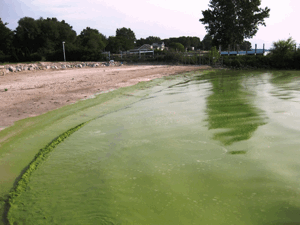
This past summer, swimmers stayed away from these algae-tainted waters. (Photo: Tom Bridgeman, University of Toledo.)
Blue green slime is choking western Lake Erie. Beaches have had swim advisories for most of the summer, water treatment systems were clogged, and the toxic algae is being blamed for a drop in walleye fish. Julie Grant reports from Ohio on what’s causing the algae and how it’s affecting tourism.
Transcript
GELLERMAN: By surface area, the Great Lakes comprise the largest body of fresh water in the world. But for the past few years a green toxic algae has been blooming in one of the Great Lakes – Lake Erie. And this past summer, the green glop has been growing out of control; threatening wildlife, swimmers and drinking water supplies. As Julie Grant reports from Ohio, scientists now say it’s just one of a number of toxic algae threatening the lake.
[WIND SOUNDS]
GRANT: It’s a windy day along the Lake Erie shoreline in western Ohio. Captain Paul Pacholski doesn’t want to battle the big waves, so he meets me inside the Lake Erie Research Center, which overlooks the water. Pacholski started a charter boat business with his father in the early 1980s. This has been one of their toughest years, because the lake is filled with algae.
PACHOLSKI: Algae was probably the worst I have seen it in the 27 years I have been doing this. It started developing probably in the middle of June, where you normally don’t see it until July. And by August it was horrendous.
GRANT: Pacholski says the pea green florescent slime made it look like his boat was moving through paint. His customers would ask ‘what’s up with the water?’ He tried to brush the algae off as no big deal. But he wouldn’t take them to his regular fishing spots – it was embarrassing.
PACHOLSKI: You would not want to stop and take customers from another state such as Wisconsin or Illinois and stop them in that water and have them look at that green broth and just know that our lake is starting to get sick.
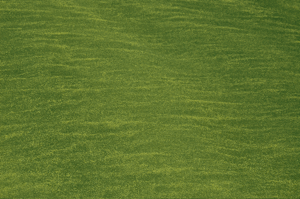
From sea to shining sea of green algae. (Photo: Tom Bridgeman, University of Toledo.)
GRANT: Pacholski says the algae cost him and other charter boat captains more than ten percent of their business this year, and he’s worried about the future of fishing here. The shallow water makes the western basin the best nursery grounds in Lake Erie for Walleye, Perch and Whitefish. These fish are the backbone of the Lake’s billion dollar fishing industry. The Ohio Department of Natural Resources says the number of Walleye have dropped from 80-million down to 20-million over the past five years. Officials and some scientists suspect it’s due to the algae.
[SOUND OF WAVES]
GRANT: Tom Bridgeman stands on the western Lake Erie Shore. He’s an environmental studies professor at the University of Toledo. And has studied microysitis and lynbia algae since 2003.
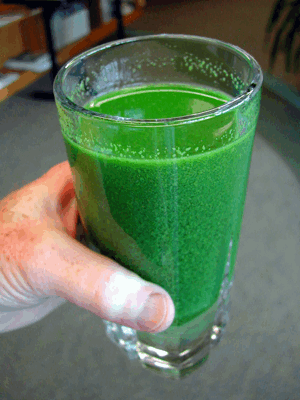
You wouldn’t want to drink this glass of microcystis. (Photo: Tom Bridgeman, University of Toledo.)
BRIDGEMAN: You see this dark-green blackish stringy looking algae, and then you see a bright green, almost florescent green scum of algae, and those are the two different kinds.
GRANT: These toxic algae have encroached on Lake Erie for seven years now. But this year it hit where people noticed: along the shorelines, in the tourist areas. Beaches were under swimming advisories most of the summer… Bridgeman says most types of algae are good for the food chain in a Lake. But this recent algae can be dangerous to people.
BRIDGEMAN: The problem with it is that it produced a toxin. And that toxin can damage the liver if it’s ingested and can cause skin rashes in some people.
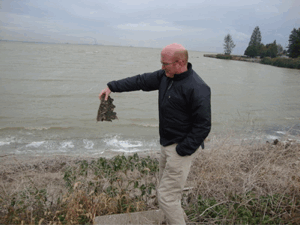
Scientist Tom Bridgeman holds a piece of lynbia. (Photo: Julie Grant)
[SOUND OF WAVES.]
GRANT: We stand on a four-foot high pile of dried algae that runs along the beach. Bridgeman says this variety is called Lynbia, and it forms what looks like a thick mat of hair along the bottom of the lake. Lynbia consumes oxygen and could cause hypoxia, suffocating fish and other organisms on the bottom of the Lake. In the past few years, Lynbia has piled on the shorelines as the weather cools in the fall.
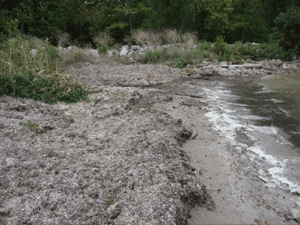
The toxic algae, lynbia, piles on the western shore of Lake Erie. (Photo: Julie Grant)
BRIDGEMAN: And when conditions are right, and the algae breaks loose from the bottom, there will be another layer of algae deposited right where we’re standing.
GRANT: The algae feed on excess nutrients in the water, especially phosphorous, from agriculture and sewage. Bridgeman remembers when Lake Erie was known as a dirty, dead lake in the 1970s. But in the wake of the Clean Water Act water quality improved. Industrial pollution was largely cut off and fish populations rebounded. There was a renaissance in tourism and fishing in the ‘80s and early ‘90s.

This past summer, swimmers stayed away from these algae-tainted waters. (Photo: Tom Bridgeman, University of Toledo.)
But in the mid 1990s, algae blooms started appearing. The EPA focused on sewer systems. In many cities such as Toledo and Detroit, the sewers can’t handle big rain events, so they wind up dumping tons of raw sewage into Lake Erie. In recent years, the government has forced cities to improve their sewers.
George Robinson is in charge of renovating Toledo’s sewer system. The 15 to 20 year project has a half-billion dollar price tag. And he says it’s already preventing overflows at the city’s water treatment plant.
ROBINSON: And fortunately, we have had at least three years where everything that goes in gets treated before it’s released. No bypasses whatsoever.
GRANT: But even as Toledo and other cities have reduced the amount of raw waste dumped into Lake Erie, the toxic algae problem has grown worse. A study released this year by the Ohio Lake Erie Phosphorous Task Force largely blames farms.
BRIDGEMAN: There’s a number of agricultural procedures that we think have changed over the last twenty years or so…
GRANT: University of Toledo’s Tom Bridgeman is a member of the Task Force. He says farmers today apply manure and fertilizers in the fall and winter, instead of just the spring. And that means more phosphorous ends up in waterways, especially now, with climate change.
BRIDGEMAN: When the ground is frozen, that tends to lock in the nutrients. But now we get big rainstorms in January, so a lot of fertilizer that’s applied can just wash of then.
GRANT: Water from six million acres, in Ohio, Indiana and Michigan, drains into western Lake Erie, so even if each farm loses a small amount of phosphorous, it can still add up to a lot in rivers and in the lake.
Bridgeman says there are efforts to work with farmers to reduce runoff of fertilizers and manure.
Captain Paul Pacholski hopes they can make a difference. As it is now, he says this could be the end of the line for the fishing business he started with his father, and a way of life.
PACHOLSKI: I would not feel safe letting my dog go in that water, or my grandson. And that’s a sorry state of events from water that we’ve all grown up with.
GRANT: For Living on Earth, I’m Julie Grant in western Ohio.
Links
View the report from the Ohio Lake Erie Phosphorous Task Force
Living on Earth wants to hear from you!
Living on Earth
62 Calef Highway, Suite 212
Lee, NH 03861
Telephone: 617-287-4121
E-mail: comments@loe.org
Newsletter [Click here]
Donate to Living on Earth!
Living on Earth is an independent media program and relies entirely on contributions from listeners and institutions supporting public service. Please donate now to preserve an independent environmental voice.
NewsletterLiving on Earth offers a weekly delivery of the show's rundown to your mailbox. Sign up for our newsletter today!
 Sailors For The Sea: Be the change you want to sea.
Sailors For The Sea: Be the change you want to sea.
 The Grantham Foundation for the Protection of the Environment: Committed to protecting and improving the health of the global environment.
The Grantham Foundation for the Protection of the Environment: Committed to protecting and improving the health of the global environment.
 Contribute to Living on Earth and receive, as our gift to you, an archival print of one of Mark Seth Lender's extraordinary wildlife photographs. Follow the link to see Mark's current collection of photographs.
Contribute to Living on Earth and receive, as our gift to you, an archival print of one of Mark Seth Lender's extraordinary wildlife photographs. Follow the link to see Mark's current collection of photographs.
 Buy a signed copy of Mark Seth Lender's book Smeagull the Seagull & support Living on Earth
Buy a signed copy of Mark Seth Lender's book Smeagull the Seagull & support Living on Earth

